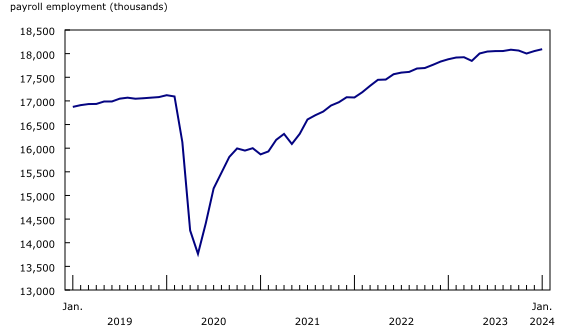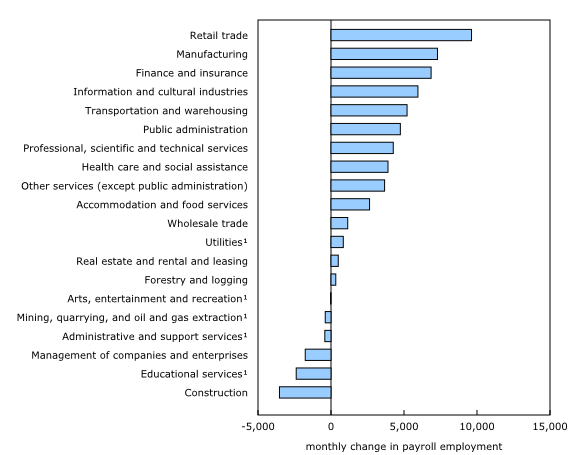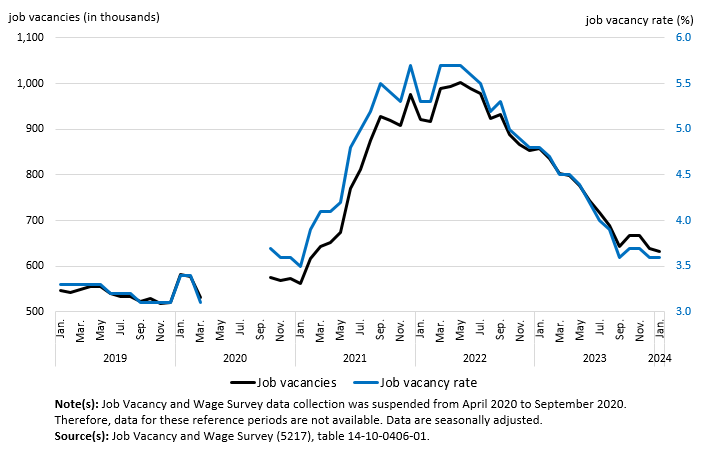Payroll employment, earnings and hours, and job vacancies, January 2024
Released: 2024-03-28
$1,228.01
January 2024
3.9% 
(12-month change)
$1,227.30
January 2024
3.5% 
(12-month change)
$1,046.64
January 2024
5.0% 
(12-month change)
$1,095.11
January 2024
6.1% 
(12-month change)
$1,130.67
January 2024
4.4% 
(12-month change)
$1,178.30
January 2024
3.8% 
(12-month change)
$1,254.05
January 2024
3.6% 
(12-month change)
$1,120.17
January 2024
3.0% 
(12-month change)
$1,178.77
January 2024
2.3% 
(12-month change)
$1,297.76
January 2024
2.5% 
(12-month change)
$1,248.37
January 2024
5.7% 
(12-month change)
$1,423.72
January 2024
6.5% 
(12-month change)
$1,592.61
January 2024
1.8% 
(12-month change)
$1,643.39
January 2024
2.1% 
(12-month change)
The number of employees receiving pay and benefits from their employer—measured as "payroll employment" in the Survey of Employment, Payrolls and Hours—increased by 39,800 (+0.2%) in January. On a year-over-year basis, payroll employment was up by 212,900 (+1.2%) in January.
Meanwhile, there were 632,100 job vacancies across all sectors in January, little changed from December, but down 34,800 (-5.2%) from November.
In January, monthly payroll employment increases were recorded in 13 out of 20 sectors, led by retail trade (+9,600; +0.5%), manufacturing (+7,300; +0.5%), finance and insurance (+6,900; +0.8%), information and cultural industries (+6,000; +1.7%) and transportation and warehousing (+5,200; +0.6%). These gains were partially offset by declines in construction (-3,500; -0.3%) and management of companies and enterprises (-1,800; -1.5%). The remaining five sectors recorded little change.
Payroll employment in retail trade rises following four consecutive monthly declines
In January, payroll employment in retail trade rose by 9,600 (+0.5%). The monthly gain in January followed four consecutive monthly declines from September to December 2023, with cumulative losses totalling 17,300 (-0.9%) over this period.
Monthly gains in January were recorded in five of the nine subsectors, led by sporting goods, hobby, musical instrument, book, and miscellaneous retailers (+4,200; +2.0%), general merchandise retailers (+2,700; +1.0%), and clothing, clothing accessories, shoes, jewelry, luggage and leather goods retailers (+1,800; +0.9%).
On a year-over-year basis, payroll employment in retail trade was down by 4,900 (-0.2%) in January.
Payroll employment in food manufacturing leads the increase in overall manufacturing
Payroll employment in manufacturing increased by 7,300 (+0.5%) in January, following little change from August to December 2023.
The largest monthly gain in the sector in January 2024 was in food manufacturing (+2,900; +1.2%), followed by transportation equipment manufacturing (+1,900; +0.9%) and plastics and rubber products manufacturing (+1,400; +1.4%).
Payroll employment increases in finance and insurance
Payroll employment in finance and insurance increased by 6,900 (+0.8%) in January, following an increase of 1,700 (+0.2%) in December 2023. Monthly gains in January 2024 were concentrated in 3 out of 11 industries in the sector, led by securities and commodity contracts intermediation and brokerage (+5,400; +10.0%).
Year over year, payroll employment in finance and insurance was up by 11,700 (+1.3%) in January.
Transportation and warehousing records a payroll employment increase in January
Payroll employment in transportation and warehousing was up by 5,200 (+0.6%) in January, following a decline of 3,000 (-0.4%) in December 2023 and four consecutive months of little change from August to November 2023.
The largest monthly gains in January 2024 were recorded in general freight trucking (+1,600; +1.2%) and urban transit systems (+1,100; +1.5%).
On a year-over-year basis, payroll employment in the sector was up by 10,800 (+1.4%) in January.
Payroll employment decreases in construction
In January, payroll employment in construction decreased by 3,500 (-0.3%), following an increase of 1,400 (+0.1%) in December 2023 and little change in November. Payroll employment in the sector generally trended down after reaching a peak in June, with a net loss of 8,800 (-0.8%) from June 2023 to January 2024.
Payroll employment in residential building construction fell by 1,500 (-0.9%) in January, following four consecutive months of little change from September to December 2023. Payroll employment in specialty trade contractors was down by 1,500 (-0.2%) in January 2024, while non-residential building construction and heavy and civil engineering construction were little changed.
Average weekly earnings increase in January
On a month-over-month basis, average weekly earnings were up 0.7% to $1,228 in January, following a decline of 0.4% in December 2023.
On a year-over-year basis, average weekly earnings grew by 3.9% in January 2024, following a 3.9% increase in December 2023. Year-over-year increases in January 2024 were largest in management of companies and enterprises (+13.7% to $1,802) and administrative and support, waste management and remediation services (+9.7% to $1,063). In general, growth in average weekly earnings can reflect a range of factors, including changes in wages, composition of employment and hours worked.
Average weekly hours worked were little changed on a monthly basis in January but were up 0.9% on a year-over-year basis to 33.5 hours.
Job vacancies see little change in January
There were 632,100 job vacancies across all sectors in January, little changed from December, but down 34,800 (-5.2%) from November. On a year-over-year basis, vacancies were down by 226,700 (-26.4%) in January.
Total labour demand, which corresponds to the sum of filled and unfilled positions, increased by 0.2% in January 2024 compared with the previous month, but was down by 0.3% from January 2023.
The job vacancy rate—which corresponds to the number of vacant positions as a proportion of total labour demand—held steady at 3.6% in January 2024, but was 1.2 percentage points lower than in January 2023 (4.8%).
There were 2.0 unemployed persons for every job vacancy in January 2024, a ratio unchanged from the previous month.
Job vacancies declined in three sectors in January: transport and warehousing (-16,300; -38.5%), manufacturing (-4,300; -10.2%), and wholesale trade (-3,900; -14.8%). These declines were offset by increases in retail trade (+6,700; +11.3%), professional, scientific and technical services (+5,000; +13.3%), finance and insurance (+3,500; +17.8%), and arts, entertainment and recreation (+2,300; +24.1%). The remaining 13 sectors were little changed.
Manufacturing records the lowest number of job vacancies since September 2017
In January 2024, job vacancies declined by 4,300 (-10.2%) to 37,500 in manufacturing, following little change in December. This was the lowest level of job vacancies the sector has seen since September 2017 (37,400). On a year-over-year basis, job vacancies were down by 29,800 (-44.3%) in manufacturing in January 2024. Over this period, total labour demand for this sector decreased by 2.2%, reflecting declines in both payroll employment (-0.4%) and job vacancies (-44.3%).
The job vacancy rate in manufacturing was 2.3% in January, down 0.3 percentage points from December 2023 (2.6%) and down 1.8 percentage points from January 2023 (4.1%). The job vacancy rate in the sector in January 2024 was the lowest rate since February 2017 (2.3%).
Job vacancies in wholesale trade fall to the lowest level in over three years
Job vacancies in wholesale trade declined by 3,900 (-14.8%) to 22,300 in January 2024, following three consecutive months of little change. This was the lowest number of job vacancies in the sector since November 2020 (21,700). The job vacancy rate in the sector was 2.6% in January 2024, down by 0.5 percentage points from December 2023 (3.1%), and by 1.1 percentage points from January 2023 (3.7%).
Job vacancies increase in retail trade
In January 2024, the number of vacant positions in retail trade rose by 6,700 (+11.3%), partially offsetting the decline in December (-10,300; -14.7%). On a year-over-year basis, vacancies were down by 28,900 (-30.5%) in January and total labour demand in the sector was down 2.2%.
The job vacancy rate in the sector was 3.2% in January, up from 2.8% in December, but down from 4.5% compared with January 2023.
Job vacancies up in finance and insurance
In finance and insurance, job vacancies increased by 3,500 (+17.8%) to 23,200 in January 2024, following a decline of 5,700 (-22.3%) in December. The job vacancy rate in the sector was up by 0.4 percentage points to 2.7% in January.
Vacancies show little change in health care and social assistance
The number of unfilled positions in health care and social assistance was 133,100 in January, little changed from the previous month and down by 15,700 (-10.5%) compared with January 2023. In January 2024, this sector accounted for more than one in five (21.1%) job vacancies across all sectors, and represented 13.7% of total payroll employment.
The job vacancy rate in the sector was 5.4% in January, down by 0.8 percentage points from the same month a year earlier (6.2%).
Job vacancies rise in Quebec and fall in Alberta, Saskatchewan, and Nova Scotia
In Quebec, the number of vacant positions increased by 17,700 (+12.7%) to 157,500 in January, more than offsetting the decrease observed in December 2023 (-13,100; -8.6%).
Meanwhile, there were fewer job vacancies in Alberta (-11,000 to 71,500), Saskatchewan (-2,700 to 18,500), and Nova Scotia (-1,900 to 14,300) in January 2024. Vacancies were little changed in the remaining provinces.
On a year-over-year basis, the job vacancy rate decreased in eight provinces in January and was little changed in Newfoundland and Labrador and Prince Edward Island. Manitoba (-1.5 percentage points to 3.4%) recorded the largest year-over-year decline in January, followed by Nova Scotia (-1.4 percentage points to 3.1%) and Ontario (-1.4 percentage points to 3.1%).
In January, British Columbia (4.3%) continued to have the highest job vacancy rate, while Ontario (3.1%) and Nova Scotia (3.1%) recorded the lowest.
Did you know we have a mobile app?
Get timely access to data right at your fingertips by downloading the StatsCAN app, available for free on the App Store and on Google Play.
Sustainable Development Goals
On January 1, 2016, the world officially began implementation of the 2030 Agenda for Sustainable Development—the United Nations' transformative plan of action that addresses urgent global challenges over the next 15 years. The plan is based on 17 specific sustainable development goals.
The Survey of Employment, Payrolls and Hours is an example of how Statistics Canada supports the reporting on the Global Goals for Sustainable Development. This release will be used in helping to measure the following goals:


Note to readers
Survey of Employment, Payrolls and Hours
The Survey of Employment, Payrolls, and Hours (SEPH) data are revised on an annual basis. These revisions also align the SEPH data with the latest standards and improve coherence with other labour market data.
With the release of January 2024 data, recent and historical SEPH monthly data have been replaced with revised estimates.
All seasonally adjusted and unadjusted monthly data series have been revised, starting in 2001, for a small number of industries to correct reporting or processing errors, or to align with the most recent North American Industry Classification System (NAICS 2022 version 1.0). Additionally, seasonally adjusted data have been revised based on the latest seasonal factors.
The key objective of the SEPH is to provide a monthly portrait of the level of earnings, employment and hours worked, by detailed industry, at the national, provincial and territorial levels.
Payroll employment, as measured by the SEPH, refers to the number of employees receiving pay and benefits (employment income) during a given month. The survey excludes the self-employed, owners and partners of unincorporated businesses and professional practices, and employees in the agricultural sector.
SEPH estimates are produced by integrating information from three sources: a census of approximately 1 million payroll deduction records provided by the Canada Revenue Agency; the Business Payrolls Survey, which collects data from a sample of 15,000 establishments; and administrative records of federal, provincial and territorial public administration employment, provided by these levels of government.
Estimates of average weekly earnings and hours worked are based on a sample and are therefore subject to sampling variability. This analysis focuses on differences between estimates that are statistically significant at the 68% confidence level. Payroll employment estimates are based on a census of administrative records and are not subject to sampling variability.
With each release of SEPH data, data for the preceding month are revised. Users are encouraged to use the most up-to-date data available for each month.
Statistics Canada also produces employment estimates from its Labour Force Survey (LFS). The LFS is a monthly household survey, the main objective of which is to divide the working-age population into three mutually exclusive groups: the employed (including the self-employed), the unemployed and those not in the labour force. This survey is the official source for the unemployment rate, and it collects data on the sociodemographic characteristics of all those in the labour market.
As a result of conceptual and methodological differences, estimates of changes from the SEPH and the LFS differ occasionally. However, the trends in the data are similar. For a more in-depth discussion of the conceptual differences between employment measures from the LFS and the SEPH, refer to Section 8 of the Guide to the Survey of Employment, Payrolls and Hours (72-203-G).
Unless otherwise stated, this release presents seasonally adjusted data, which facilitate comparisons because the effects of seasonal variations are removed. For more information on seasonal adjustment, see Seasonally adjusted data – Frequently asked questions.
Non-farm payroll employment data are for all hourly and salaried employees and for the "other employees" category, which includes piece-rate and commission-only employees.
Unless otherwise specified, average weekly hours data are for hourly and salaried employees only and exclude businesses that could not be classified to a NAICS 2022 version 1.0 code.
All earnings data include overtime and exclude businesses that could not be classified to a NAICS code. Earnings data are based on gross taxable payroll before source deductions. Average weekly earnings are derived by dividing total weekly earnings by the number of employees.
Job Vacancy and Wage Survey
The Job Vacancy and Wage Survey (JVWS) data have been revised historically to align with the latest standards and improve the coherence with other labour market data.
With the release of the January 2024 data, all monthly seasonally adjusted and unadjusted data series starting from April 2015 are revised to the NAICS 2022 version 1.0 and the Standard Geographical Classification (SGC) 2021.
JVWS collection is done on a quarterly basis. The quarterly sample of business locations is allocated to the three collection months of the quarter, approximately balanced by province and by industrial sector across each of the three months. This allows both quarterly and monthly estimates to be produced.
Preliminary monthly estimates are produced for job vacancies, job vacancy rates and payroll employment using available responses from business locations sampled in the corresponding reference month. The reference period for the JVWS is the first day of the respective month.
These preliminary monthly estimates are revised and finalized when the corresponding quarterly estimates are released or shortly thereafter. Users are encouraged to use the most up-to-date data available for each month.
Unless otherwise stated, this release presents seasonally adjusted data, which facilitate comparisons because the effects of seasonal variations are removed. For more information on seasonal adjustment, see Seasonally adjusted data – Frequently asked questions.
While JVWS employment is calibrated to the SEPH, SEPH payroll employment and JVWS preliminary monthly employment figures may differ because of calibration grouping and differences in scope and reference period.
The JVWS also provides comprehensive quarterly data on job vacancies by industrial sector and detailed occupation for Canada and the provinces, territories and economic regions; offered hourly wages; and job vacancy characteristics. More information about the concepts and use of data from the JVWS is available in the Guide to the Job Vacancy and Wage Survey (75-514-G).
Real-time data tables
Tables 14-10-0357-01 and 14-10-0358-01 have now been archived.
Real-time data tables 14-10-0331-01 and 14-10-0332-01 will be updated on April 15, 2024.
Next release
February data for SEPH and JVWS will be released on April 25.
Products
More information about the concepts and use of the Survey of Employment, Payrolls and Hours is available in the Guide to the Survey of Employment, Payrolls and Hours (72-203-G).
The product "Earnings and payroll employment in brief: Interactive app" (14200001) is now available. This interactive data visualization application provides a comprehensive picture of the Canadian labour market using the most recent data from the Survey of Employment, Payrolls and Hours. The estimates are seasonally adjusted and available by province and largest industrial sector. Historical estimates that go back 10 years are also included. The interactive application allows users to explore and personalize the information presented quickly and easily. Combine multiple provinces and industrial sectors to create your own labour market domains of interest.
Contact information
For more information, or to enquire about the concepts, methods or data quality of this release, contact us (toll-free 1-800-263-1136; 514-283-8300; infostats@statcan.gc.ca) or Media Relations (statcan.mediahotline-ligneinfomedias.statcan@statcan.gc.ca).
- Date modified:



